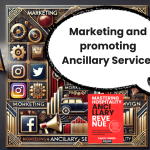In the hospitality industry, the guest experience is the lifeblood of success. While delivering excellent service is the baseline, a guest-centric approach can unlock untapped ancillary revenue potential. This means understanding guest needs deeply, personalizing offerings, and seamlessly integrating value-added services into the guest journey.
Here’s a comprehensive guide to implementing guest-centric strategies that not only delight your customers but also boost your bottom line.
1. Personalization: The key to a guest-centric approach
Guest-centricity begins with personalization. Every guest has unique preferences, and by harnessing the power of data analytics, you can tailor your services to meet their specific needs. Imagine this:
A returning couple celebrates their anniversary with you every year. Through data analytics, your team offers a personalized romantic package including wine, a private dining experience, and late checkout.
A frequent business traveler is presented with quick laundry services, co-working spaces, and express check-out options.
Hotels that can anticipate guest needs make the stay memorable and increase the likelihood of upselling success.
2. Proactive engagement before and during the stay
The guest journey begins long before check-in. Effective engagement at every stage—from booking to post-stay follow-up—is essential for driving ancillary revenue.
Pre-arrival:
Send personalized pre-arrival emails showcasing tailored offerings like spa appointments, room upgrades, or curated local tours.
Implement tools like Oaky to automate upselling efforts and ensure your guests see value in your additional services.
During the stay:
Equip your staff with CRM systems that highlight guest preferences and past behaviors.
Use in-room tablets or apps to introduce relevant offers in real-time. For instance, a notification suggesting a sunset yacht tour could resonate with leisure travelers.
3. Creating emotional connections with guests
Upselling and cross-selling should not feel transactional. Guests are more likely to purchase additional services when they perceive an emotional connection with the brand. Train your staff to:
Engage guests in meaningful conversations to uncover their preferences.
Use these insights to recommend services that elevate the experience, such as suggesting a premium spa treatment to a guest discussing their need for relaxation.
Upselling with empathy ensures that recommendations align with guest needs, making the experience seamless and enjoyable.
4. Maximizing mid-stay revenue opportunities
Once guests are settled in, mid-stay opportunities are abundant:
Offer exclusive in-stay deals, such as discounts on additional nights or dining promotions for midweek stays.
Use feedback tools to identify opportunities to address guest needs proactively. For instance, if a guest mentions wanting more dining options, present them with a private dining package.
5. Post-stay marketing for long-term revenue
The guest journey doesn’t end at check-out. Use post-stay engagement to encourage repeat visits:
Send personalized thank-you emails with exclusive offers for their next stay.
Leverage loyalty programs to promote bundled packages that combine accommodations with ancillary services.
Conclusion
Guest-centric strategies focus on creating memorable experiences that resonate with individual preferences. By engaging with guests proactively, leveraging data insights, and fostering emotional connections, you can significantly boost ancillary revenue while building long-term loyalty. Remember: a delighted guest spends more—and keeps coming back.

